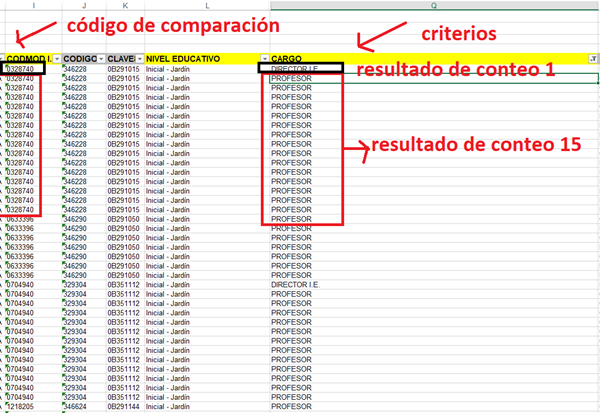Suponiendo lo siguiente:
- Libro 1, códigos empiezan en D2.
- Libro 2, códigos empiezan en I6
- Puse en un arreglo los nombres ordenados como los tienes en el libro 1.
- Los nombres empiezan en la columna P
Nota: Agrega la parte para abrir el archivo.
Entonces prueba lo siguiente:
Sub compara_codigos()
Dim wb1 As Workbook, wb2 As Workbook
Dim sh1 As Worksheet, sh2 As Worksheet
Dim dic As Object
Dim a As Variant, b As Variant, c As Variant
Dim crit As Variant, arch As Variant
Dim i As Long, fila As Long, col As Variant
'
Application.ScreenUpdating = False
'
crit = Array("DIRECTOR I.E.", _
"SUB-DIRECTOR I.E.", _
"COORDINADOR PEDAGOGICO", _
"COORDINADOR DE TUTORIA Y ORIENTACION EDUCATIVA", _
"COORDINADOR ACADEMICO", _
"JEFE DE LABORATORIO", _
"JEFE DE TALLER", _
"PROFESOR", _
"PROFESOR - AIP", _
"PROFESOR - EDUCACION FISICA", _
"PROFESOR COORDINADOR", _
"PROFESOR (FUNCIONES DE DIRECTOR)", _
"AUXILIAR DE EDUCACION")
'
Set wb1 = ThisWorkbook
Set sh1 = wb1.Sheets("DOCENTES")
arch = "Libro2.xlsx"
Set wb2 = Workbooks.Open(arch)
Set sh2 = wb2.Sheets(1)
Set dic = CreateObject("Scripting.Dictionary")
'Matriz códigos de libro1
a = sh1.Range("D2:D" & sh1.Range("D" & Rows.Count).End(3).Row).Value
'matriz de resultado del libro1
ReDim b(1 To UBound(a, 1), 1 To 13)
'matriz de libro2
c = sh2.Range("I6:Q" & sh2.Range("I" & Rows.Count).End(3).Row).Value
'llenar el índice del libro1
For i = 1 To UBound(a, 1)
dic(a(i, 1)) = i 'número de fila en la matriz
Next
'lee datos del libro2
For i = 1 To UBound(c, 1)
If dic.exists(c(i, 1)) Then
fila = dic(c(i, 1))
col = Application.Match(c(i, 9), crit, 0)
If Not IsError(col) Then
b(fila, col) = b(fila, col) + 1
End If
End If
Next
sh1.Range("P2").Resize(UBound(b, 1), UBound(b, 2)).Value = b
wb1.Activate
End Sub



